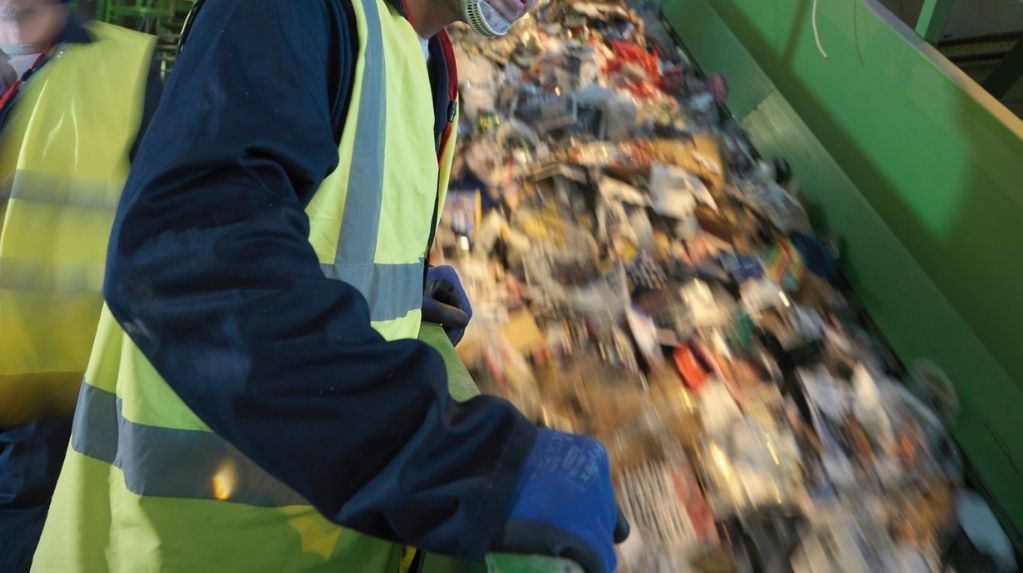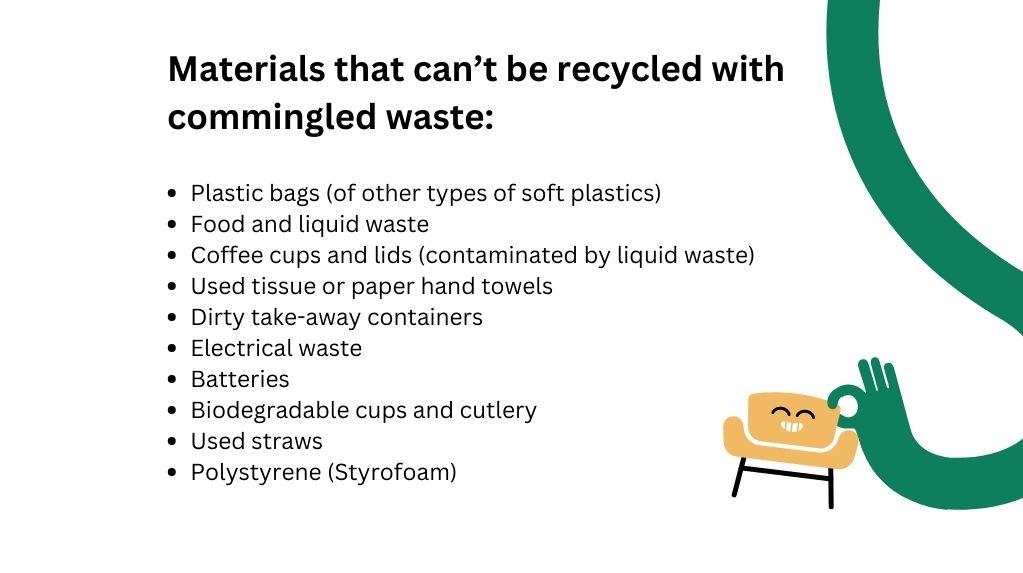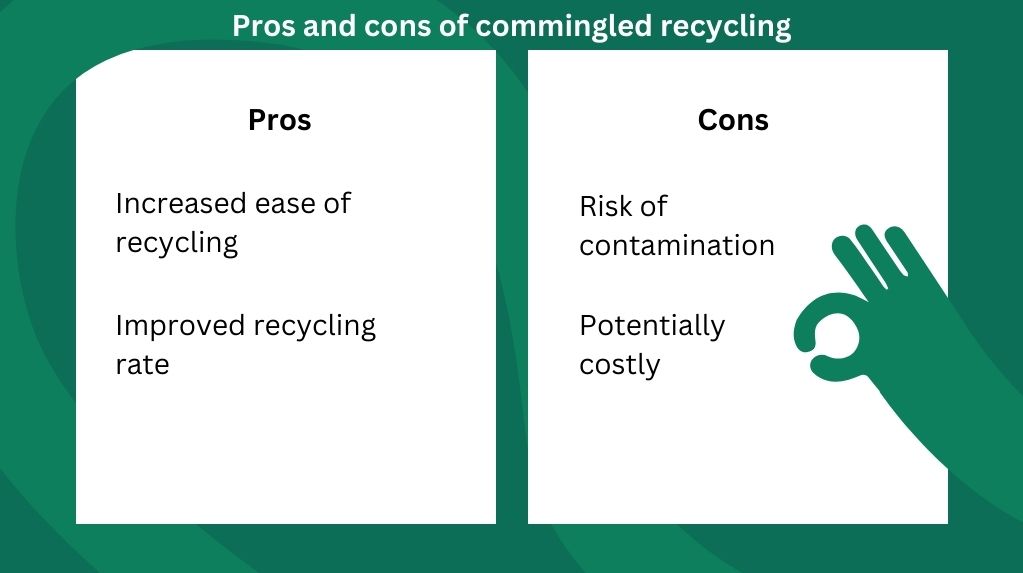
Commingled recycling, also commonly referred to as single-stream recycling in the industry, is a method of waste management that involves the collection of various types of recyclable materials together within the same channel.
With recycling rates in Australia at 60% (as of 2021), the nation is in desperate need of a boost to align with global recycling rates. Commingled recycling as a possible solution to increase recycling participation by offering an easy method of recycling.
So, how exactly does commingled recycling work? And is it the best way to approach recycling? Read on to find out.
What’s classed as commingled waste?
Commingled waste varies across different types of waste that can be easily recycled. In Australia, the following types of rubbish and material are classified as commingled waste:
- Hard plastic products (plastic containers, plastic bottles)
- Cardboard and paper waste (newspapers, clean cardboard boxes)
- Glass material and containers (glass bottles, glass jars)
- Disposable metal products (aluminium cans, steel cans, tin canisters)

What can’t mix with commingled waste?
Not every item that seems to be easily recycled can be mixed with commingled waste. As commingled recycling already accepts a mixture of waste material, it’s critical to avoid disposing of certain types of rubbish that can potentially complicate the sorting and recycling process.
Specifically, the following materials can’t be recycled with commingled waste:
- Plastic bags (of other types of soft plastics)
- Food and liquid waste
- Coffee cups and lids (contaminated by liquid waste)
- Used tissue or paper hand towels
- Dirty take-away containers

The inclusion of these materials can often contaminate the commingled waste recycling process, resulting in unhygienic and potentially damaging consequences to the recycling equipment. Soft plastics can rip apart and clog up equipment, and food waste poses a biohazard to waste processing employees.
What happens to commingled recyclables?
So, what exactly happens to commingled waste, and what does the recycling process look like?
When commingled recyclables are collected, they are transported via truck to a materials recovery facility (MRF) where they will undergo processing. Before the different materials can be recycled, they must first be sorted.
At most MRFs, the collected commingled waste will be deposited onto a conveyor belt where staff members will identify and remove any items that cannot be recycled by hand. This is a time consuming process, which is why it’s so important to understand what can and can’t be placed in the commingled recycling bin.
Once the non-recyclable materials are removed from the process, the rest of the commingled waste is further sorted through a weight “filter” which allows lighter materials such as paper or cardboard waste to be separated from heavier materials. The heavier remaining mixture of material is passed under a large magnet to remove metal waste.
An additional layer of physical checks is conducted by MRF staff to ensure that all the items have been correctly sorted, after which each of the recyclable materials (glass, metal, paper) are transported to their respective recycling facilities to be processed into new products or resources.
Pros and cons of mixed recycling
Commingled recycling is an efficient method for collecting commonly recycled materials that are disposed of every day that would otherwise end in the general waste bin. That being said, there are also pros and cons to this method of mixed recycling.
Pros of mixed recycling
Increased ease of recycling
From the perspective of consumers, mixed recycling makes recycling a whole lot more accessible. In fact, the yellow-lid bins in each household are a form of mixed recycling collection — the items that can be disposed of in these bins are similar to the guidelines we’ve shared above. This makes recycling much easier at home, and anywhere where commingled recycling bins are available, such as train stations.

Improved recycling rate
By making recycling more easy to carry out, mixed recycling has also shown an ability to improve the rate of recycling in an area. A report by the Department of Environment and Conservation (NSW) on the effectiveness of commingled recycling systems substantially increased the rate and benefit of recycling in public areas and among households.
Cons of mixed recycling
Risk of contamination
The risk of contamination from food waste or other chemicals is one of the biggest problems that consistently plague mixed recycling systems. When disposed recyclables are not clean from food or liquid waste, they may end up affecting the quality of the recyclable material, causing it to be of poorer quality.
Glass that shatters during disposal or transport is also another problem — shattered glass pieces are impossible to separate completely during the sorting process, causing it to contaminate recycled material in the same way.
Potentially costly
The sorting process for mixed recyclables is not only time consuming, but also potentially costly when incorrect items are put through the sorting process. Items like Styrofoam and plastic bags are one of the most common offenders of this, and their ability to break apart into smaller pieces can often clog up machinery, causing damage to essential and expensive equipment.
Let Ridly take care of your recycling
While commingled recycling is ideal for simple types of everyday materials, it’s not a solution for more difficult to recycle items like old furniture or broken appliances. Not only do these items not fit in the bin, but they are also too heavy and bulky to transport.
In such cases, a rubbish removal service is like Ridly is your best option to recycle your unwanted household items properly and sustainably. With our same-day rubbish removal services, our expert team of removalists can collect your junk quickly and take it to the right recycling facility to be processed for your peace of mind. If you need help getting rid of in Sydney, we’re the rubbish removal service you can rely on!